Archive Page 47
September 19th, 2012 by dave dorsey

New Dams in Winter, detail, Neil Welliver, 1982
I know it’s bullshit to do two Art I Loves in a row, but I’m busy painting for a show in October, so bite me.
Sorry about that. I’m under pressure. Ok, so instead of just posting an image, I’ll let Neil Welliver say some things I’ve never forgotten since I first read them, things I think about often when I paint, especially when I’m “going back over” which Welliver said he never did. I usually think of Welliver when the work I’m doing isn’t remotely like Welliver’s.
Anyway, here’s an excerpt from an interview in a book published 25 years ago, Realists at Work, by John Arthur, (Watson-Guptil Publications) which I bought probably 20 years ago. It’s fun listening to Welliver sound as if he’s patronizing Fairfield Porter, who seems more and more influential a quarter century hence, especially in a lot of work I’ve seen the past few years in New York City. Welliver and Porter’s work both seem to spring from similar imperatives about simplicity and transparency of execution, paint as an end in itself rather than just a means, and the abstract qualities of representational images. His sense of color is different from Porter’s, not nearly as warm nor as varied, but you still have the sense that both artists wanted you to see the paint on its own terms, paint as what it is you’re getting, even as you see through it into the scene. Both thought of themselves as painting the light between objects, light as a field of energy, rather than representing a set of objects. Some of the Q/A:
When Porter did a really top-notch painting, he was as good as one can get . .
I think that the Fairfield Porter paintings that are good are very, very good American paintings. God knows that they can never be dismissed. I can’t imagine that. But whether Fairfield’s a major painter or MORE
September 18th, 2012 by dave dorsey
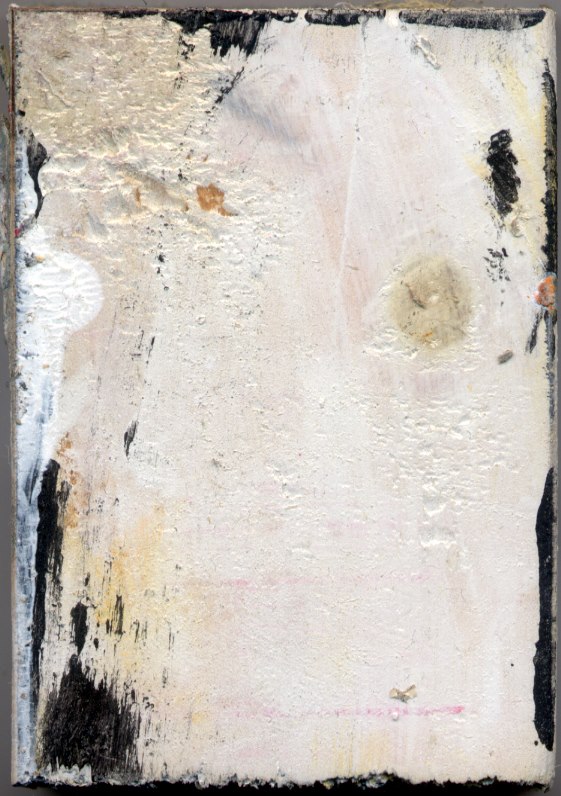
A recent painting from Kurt Ketchum.
September 13th, 2012 by dave dorsey
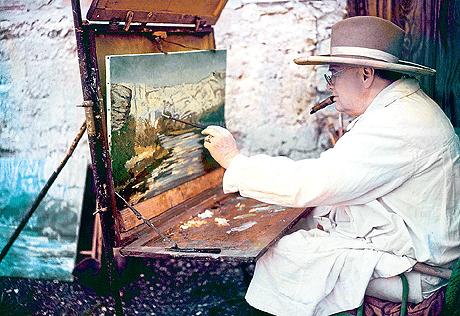
Churchill at his easel
”Happy are the painters, for they shall not be lonely. Light and colour, peace and hope, will keep them company to the end of the day.” – Winston Churchill
From Wired.com: In between penning epic one-liners, drinking, and saving western civilization, Winston Churchill picked up oil painting as a hobby. Inspired by the work of John Singer Sargent and Walter Sickert, Churchill managed to finish over 500 paintings, when World Wars weren’t getting in the way. He focused on calm landscapes — relaxing fare to keep his mind off of military failures in his past and the Panzer battalions amassing on the other side of the English Channel.
His aim was contentment, not critical acclaim. He said ”Happy are the painters, for they shall not be lonely. Light and colour, peace and hope, will keep them company to the end of the day.”
Though he didn’t pick up a paintbrush until his 40th birthday, by the end of his life Churchill was a knight, a Nobel Laureate, but also had his paintings honored by the Royal Society of the Art under the pseudonym “Mr. Winter.” Today his paintings are collected and sold at auction where one recently sold for over a million dollars.
(Click on the image of Churchill for a contrary opinion about the happiness of painters.)
September 13th, 2012 by dave dorsey
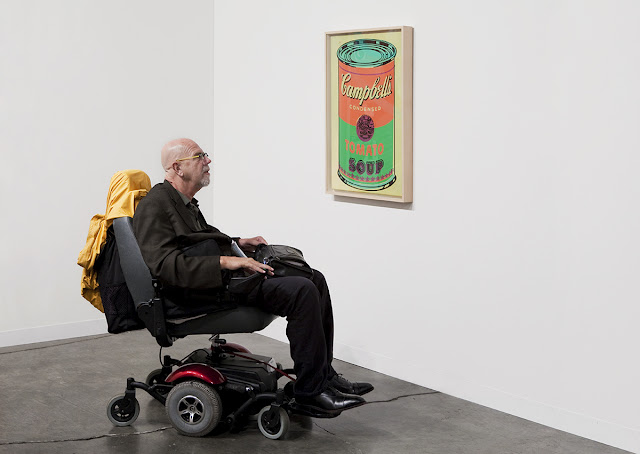
Chuck and Andy
“Photographer Andy Freeberg as been fascinated with the gallery and museum worlds for a long time and often turns his camera on the dealers, gallery patrons, artists, museum guards, and their interplay with the works of art themselves. His project Guardians, about the women that guard the art in Russian museums, won Photolucida’s Critical Mass book award and was published in 2010. One of my favorite series, Sentry, takes a look at galleristas that stand guard at the reception desks in the world of Chelsea galleries in NYC.”
–Lensscratch
September 7th, 2012 by dave dorsey
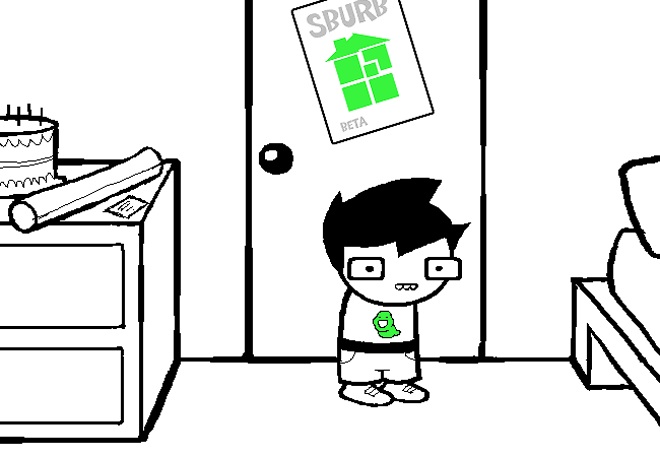
Homestuck, a “a book/webcomic/Flash animation/videogame hybrid”
When I heard that a webcomic called Homestuck had raised three quarters of a million dollars on Kickstarter within 24 hours for a videogame version, I set out to research what it was. Three hours later, I was not much closer to understanding it.
Homestuck, and the rabid fandom of its millions of readers, is difficult to explain. Entire blogs have been started just to answer the question, “What is Homestuck?”
Here’s the best I can do: It’s a book/webcomic/Flash animation/videogame hybrid, all created by Andrew Hussie. When Hussie revealed a Kickstarter campaign to fund creation of a Homestuck adventure game on Tuesday, his fans helped him meet his $700,000 goal within just one day. He plans to release the game in 2014.
—Wired.com
September 6th, 2012 by dave dorsey
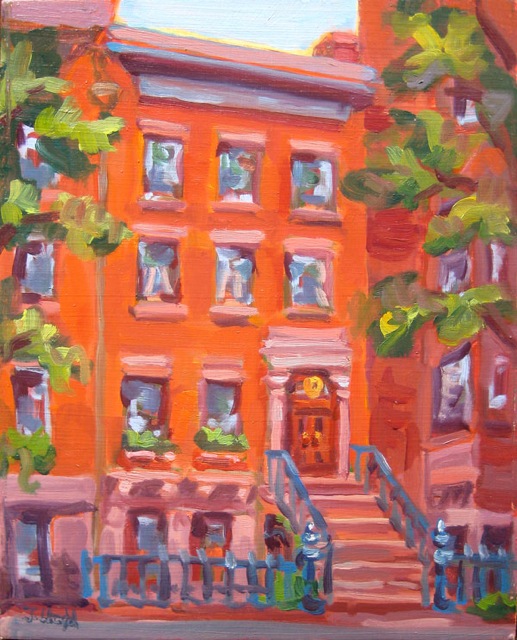
John Lloyd, Classic Brooklyn Townhouse, 2011
New York from Brooklyn to the High Line, Salon d’Art, until Oct. 2.
September 6th, 2012 by dave dorsey
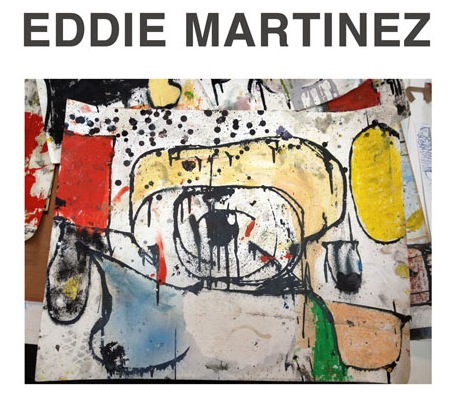
From an essay in a forthcoming book of Martinez drawings:
Martinez isn’t afraid to make abstract expressionist paintings or cubist paintings or whatever. Movements and styles don’t have a sell by date. As long as artists can genuinely expand on a movement (I think groove is actually a better word) its completely valid. Dada and surrealism are as relevant today as ever, whatever they’re called. Eddie Martinez isn’t snowed by the notion of progress in art, as 99% of artists are. What makes his art really modern or contemporary is that it’s a powerful reflection of this moment, it vibrates with the rhythm of our microsecond saturated, overdubbed, post-logical era. This is an era that has outlasted art movements and hidden beauty away where the salesmen can’t readily find it. This is a moment where every artist is fighting a sketchbook war, informed and sustained by secret muses,against historians wired into suicide vests working for international banks. The artists might be making money, but they know it’s money with secret codes set to go off when least expected.
Glenn O’Brien
September 6th, 2012 by dave dorsey

September 5th, 2012 by dave dorsey
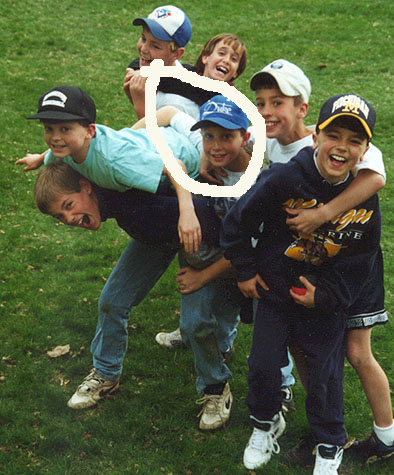
David Cowan, beta version, with Matt Dorsey, Wolverine wannabe, far right
David Cowan paid a visit to Casa Dorsey a few days ago, since we missed him when we were doing our one annual vacation last month in Southern California where our son and daughter both work now. I’ve known David since he was about knee-high, one of my son’s lifelong friends who has moved to L.A. to seek his fortunes as a screenwriter. He was back in Rochester visiting family and friends and stopped in to catch up. He’s bearded now, wears cool shoes, and comes up with about 250 new ideas for movies in the course of a week. Talk to him for MORE
September 5th, 2012 by dave dorsey
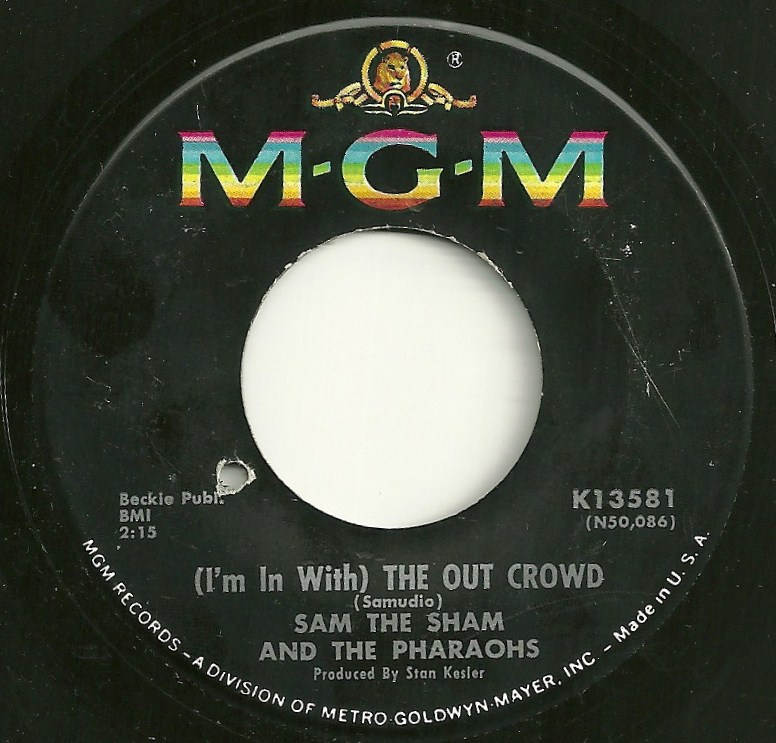
September 4th, 2012 by dave dorsey
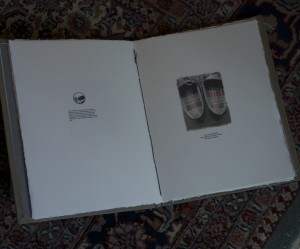
The Turning Season, handmade, clothbound chapbook at Viridian Artists
Over the past month I’ve become obsessed with creating a set of handmade books. I’ve never done this before. I essentially took lessons from the wealth of information available on the web, including many videos, so whatever craftsmanship I’ve achieved has been earned through many setbacks, mistake, do-overs, workarounds, and overall general trial-and-error. In the end, as of today, my efforts have resulted five sets of two-volume paperback chapbooks to show for my effort, and five clothbound, hardback single-signature chapbooks—a limited first edition. It’s been a long journey, but far more gratifying than I suspected it would be. In an age when the rate of e-book rentals at public library is skyrocketing, I like sinking into the long, slow, deliberate building of a physical book with an inkjet printer, printmaking paper, thread, binder’s board, bone folders, awls, glue and cloth, in a way that can’t possibly make me the kind of money that would justify the amount of time and, yes, cash, I’ve invested in the process. It’s been a labor of deep love, on a book that expresses some of my most fundamental values, and after working so many years on a story that has yet to find its conclusive form, it’s gratifying to see this small, elliptical child of that larger, difficult parent finally become something I can hold in my hands. When I see the final book, I feel: This is me. As much as anything I’ve created in my life, this is me. This is what I wanted these pictures and haiku poems to be when I first created them a number of years ago.
I backed into these weeks of consuming passion as a response to the theme of the next group show at Viridian Artists thanks to Vernita N’Cognita: Yin and Yang, a Fusion of Opposites. The show highlights the way member artists have drawn from Eastern traditions for inspiration or technique or a sense of purpose in their work. A few days after I heard about the theme of the show, it occurred to me to resurrect this series of drawings and poems I created as an appendix for a novel I wrote over the past decade but have never published, nor satisfactorily finished. Viking/Penguin published my first novel in the late 90s and since then I’ve either been working on this one—in between periods of writer’s block that many people call making a living. The novel is called The Turning Season. So is the book I’ve just designed, printed, and bound by hand. (I would have made the paper as well, if I’d had the time—and, well, if I’d ever actually made my own paper. Maybe that can wait for a second edition . . .)
The ten drawings I did for the novel were created as the work of two fictional characters in the novel: Rob Hapworth and Jill Pickett. They meet on vacation, they are attracted to one another, but they pull apart out of an obligation to people they already love, and yet they sublimate their affection for one another through a set of poems and drawings: Rob writes the poems and Jill does the drawings to match them. In the process, she delves deeply into a number of traditions and imaginative works, from the Buddhist Ox-Herding Songs to the central structure of Joseph Campbell’s monomyth to The Wasteland as well as Jung’s Psychology and Alchemy. In other words she turns a set of simple haiku poems that chart the pull and push of her relationship with Rob into a reworking of an ancient mythic structure she detects at the heart of all these other sources: a universal spiritual journey toward fulfillment through loss. I spent more than a year writing the poems and taking the photographs to use as the basis for pastel drawings on watercolor paper, to accompany the poems. In other words, I did what Jill ostensibly does in the story. And then, when I put the novel aside, I hung the pictures on my wall and moved on to other things for the past few years. Until now.
Now I’m thinking I need to return to my manuscript and finally finish the novel.
August 29th, 2012 by dave dorsey
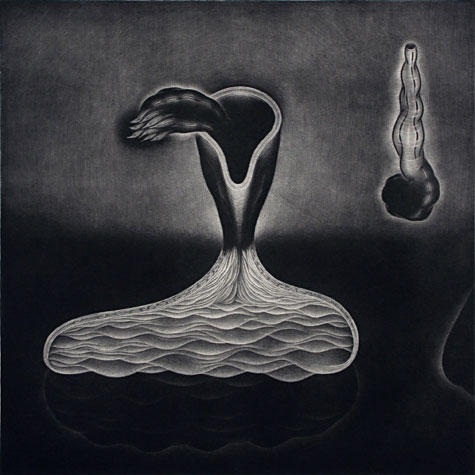
Steam of Lethe, Sean Caulfield
Manifest is offering a fascinating exhibit right now: two artist’s books that use printmaking to merge images and poetry inspired by Dante’s Inferno and Purgatorio. The work draws on visions from the Italian poet’s trilogy and then reworks them as a way of meditating on what Sean Caulfield sees as the contemporary crisis of our relationship to the natural world, including the human body itself. Caulfield, a Canadian artist, got the project rolling by devising images inspired by scenes in Dante’s great poem. Caulfield is a Centennial Professor in the Department of Art and Design at the University of Alberta, and has exhibited his prints, drawings and artist’s books extensively throughout Canada, the United States, Europe, and Japan. He took his images first to Jonathan Hart who wrote poetry based on Caulfield’s work, at which point the collaborators called on Sue Colbert who helped create a unified, integrated book out of the work they’d produced. Caulfield was originally inspired by William Blake’s illustrations for Dante and Milton, as well as that brilliant, eccentric poet/printmaker’s ability to weave his world out of both text and visual imagery.
What inspired me to send questions to Caulfield about his work was his reverence for poetic and artistic tradition—his eagerness to see contemporary relevance in work done centuries ago. More
August 28th, 2012 by dave dorsey

Kenny Schachter
Yesterday, an interesting and funny and startling conversation took place on Facebook between the informed and thoughtful curator Todd Levin and the self-described art hustler and polymath Kenny Schachter. It was a little like watching a car crash in real time, though no one really got hurt. More like a couple clown cars in a demolition derby. The conversation revolved around something Schachter wrote about Gallery Girls, a reality TV program built around the lives of young gallery workers. So this all started with a post from Schachter, who now does his thing in London. He’d gotten a scathing letter from the husband of a woman who had appeared in one episode of the show. His post:
Who is the poison pen in this instance, can someone please let me know, am i so terrible? Here is a scathing email I received, all because of this crap tv show I was asked to watch that was supposedly about the art market, not anyone’s academic achievements or accomplishments. Sorry.
Kenny,
I am a friend and subscriber of Marc Faber’s and so have read your art world More
August 27th, 2012 by dave dorsey
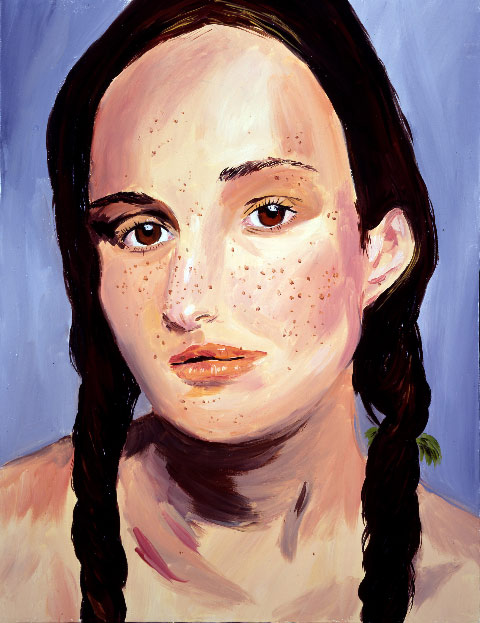
Karen Kilimnik, Me, Corner of Haight & Ashbury, 1966, 1998
Water soluble oil color on canvas
Should have started doing this from day one. A new, occasional department: Art I Love. Just great pictures, no words. (This was from a fascinating show Todd Levin curated.)
August 26th, 2012 by dave dorsey
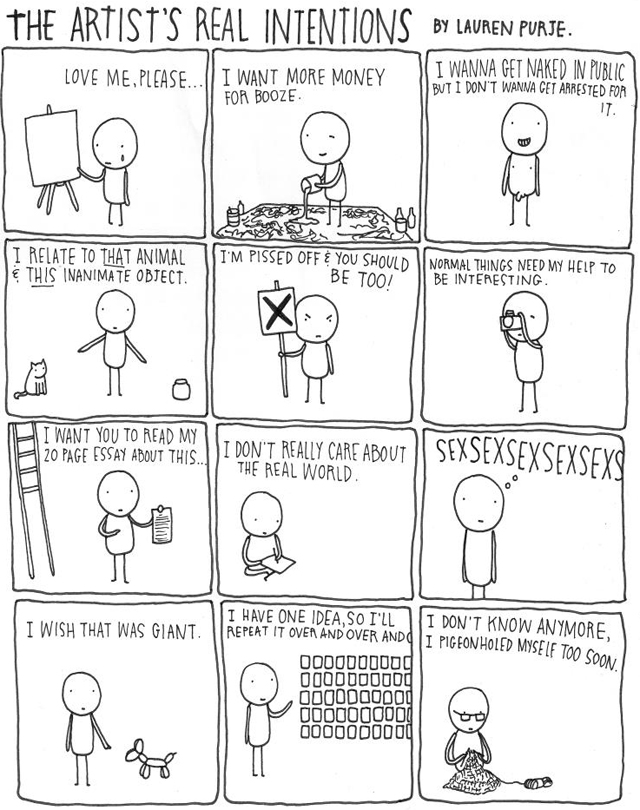
Lauren sent me an email a couple days ago: “Have you seen Hyperallergic today?” I knew what that meant. I don’t get many emails from her that don’t circle around to the subject of what she’s up to, so I figured somebody high on the 26th floor at Hyperallergic World Headquarters must have finally detected the sound of her painting boots stomping the floorboards at 3 a.m. all the way over on the other side of Brooklyn. Along with strains of Tom Waits from her Macbook. (That’s when she’s usually hard at work on her comics and paintings. I don’t think she actually sleeps.) So I clicked and found that one of my favorite art blogs had discovered her poster, which got tons of shares when she put it up on Facebook a while back. Right after she drew this, earlier this year, she showed it to me, while I was visiting Brooklyn, and pointed toward one of the panels and said, “That’s you.” At the time, I thought, “Oh, cool. I inspired one of these!” Upon further investigation (in other words, Lauren told me to get over myself, I wasn’t her inspiration) she merely meant that, as an artist, she was able to pigeonhole me into one of her well-observed categories. (This flattered me at first and then made me uncomfortable. Lauren’s too intelligent. She sees exactly where most things fall short of the ideal, and shortfall is my niche.) It’s unclear, at this point in time, which panel she meant when she was putting me in my place. I thought it was “Normal things need my help to be interesting.” However, she insists there’s a jar in here somewhere, and she knows I love to paint jars. Here’s the thing, though. Now I recognize myself in more than one of these drawings. At least three of them. Hm. No, five, actually. OK, this is as high as I’m going to go: eight. I’m definitely in eight of these. As Charlie Brown would have said if Lucy had drawn this: I am the inspiration for this comic, Linus! Then Lucy decks him with a roundhouse left.
One thing, though. Zero desire to get naked in public. Not that anyone was hoping.
August 16th, 2012 by dave dorsey

Playtime, by Deborah Parkin
When I read this, I thought, yes! That’s exactly right! And then I reread it and realized that this would be something almost anyone who practices any kind of unrecognized art would think. Which doesn’t make it any less valuable, of course, but it was the way she worked in her children and possible grandchildren that somehow caught my eye. And also the quality of what she’s doing in the context of her struggle with obscurity. “I have also found the Internet . . .” Funny. Uh, yeah, Deborah. Ampersands and all.
From Lenscratch:
As an emerging photographer, what insights can you share?
For me, it’s always been about the work. I never really imagined being published or having gallery representation etc – things like that were for other people. I just wanted to be a good photographer and leave something, a legacy for my children & maybe grandchildren. So ultimately I feel you need to work hard, learn your craft & be passionate about your subject. Do it for yourself because not everyone will like what you do & you can’t please everyone, so you must love doing what you do. I have also found the Internet to be an excellent way of sharing work & for being inspired by other artists too.
August 7th, 2012 by dave dorsey
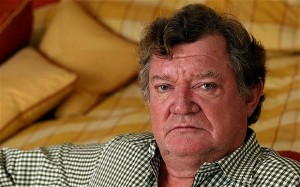
“Although art has always been a commodity, it loses its intrinsic value and its social use when it is treated only as a commodity. To lock it into a market circus is to lock people out of the contemplation of it. This inexorable process tends to collapse the nuances of meaning, and visual experience generally, under the brute weight of price. It is not a compliment to the work. If there were only one copy of each book in the world, fought over by multimillionaires and investment trusts and then hidden in storage, what would happen to one’s sense of literature—the tissue of its meanings that sustain a common discourse?”
Even better:
“The Cultural Cringe is the assumption that whatever you do in the field of writing, painting, sculpture, architecture, film, dance, or theater is of unknown value until it is judged by people outside your own society. It is the reflex of the kid with low self-esteem hoping that his work will please the implacable father, but secretly despairing that it can. The essence of cultural colonialism is that you demand of yourself that your work measure up to standards that cannot be shared or debated where you live. By the manipulation of such standards, almost anything can be seen to fail, no matter what sense of finesse, awareness, and delight it may produce in its own setting.”
–Robert Hughes
1938-2012
July 29th, 2012 by dave dorsey
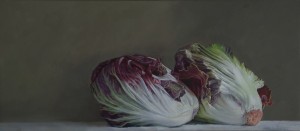
Radicchio from Ithaca, oil on linen, 16″ x 36″
We bought these on a trip down to the public market on Cayuga Lake, in Ithaca, a few weeks ago and I was fascinated by the elongated shape and variegated color, as well as the twists and flares in the leaves. I wish I’d asked how the vendor grew them. I’d try some myself next summer. Our lettuce is just about done, but the cherry tomatoes are starting to get red.
July 22nd, 2012 by dave dorsey
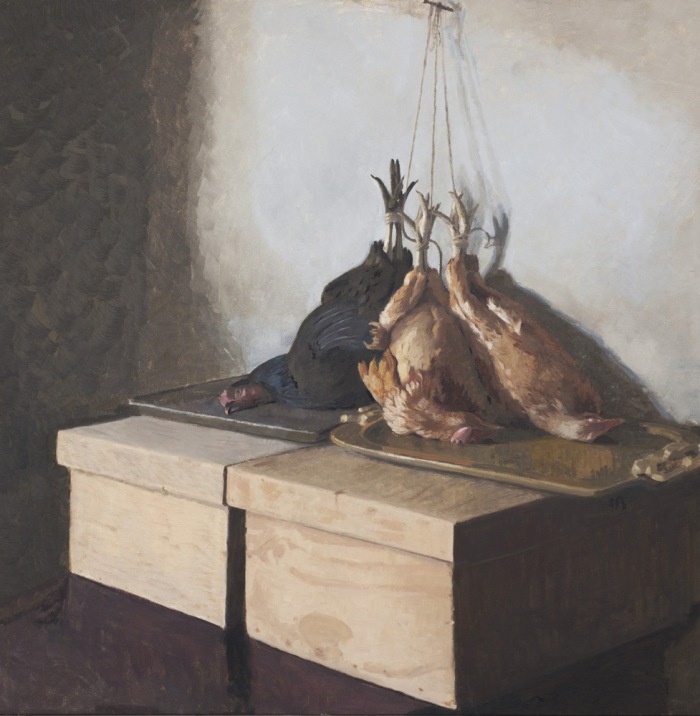
Poultry for Smithfields, Sarah F. Burns
When I saw this, it reminded me of two different paintings by Chardin (also involving game birds one step away from the oven), both in the choice of subject, the simplicity of the staging and in the handling of paint. Great work, part of an interesting and compelling series of vanitas paintings by Sarah F. Burns in Oregon. At one point, the project involved dragging a bloody bear carcass into her Ashland studio. This woman is serious about her meat. And her art. Her friend Jennifer Nitson interviewed Sarah and came away with a nice small profile of the artist containing a wonderful, illuminating quote: “I have been particularly interested in small-scale meat production and nose-to-tail eating because I grew up in that type of lifestyle. My father was a farm-kill butcher when I was born. That means he went from farm to farm killing livestock and brought them back to the butcher shop to cut up and wrap.” The work was commissioned by a local restaurant in Ashland, named after a London market. As Sarah puts it on her blog: “Smithfields is . . . named after a London meat market with a very long history, going back to the middle ages where it was the place of public executions, becoming a livestock market, and is currently a wholesale meat market today.”
It’s sense of timelessness is what especially appeals to me about this work. It could have been painted two centuries ago and yet it looks totally contemporary as well. I guess that last sentence is just a long way home to the word classic.
July 18th, 2012 by dave dorsey
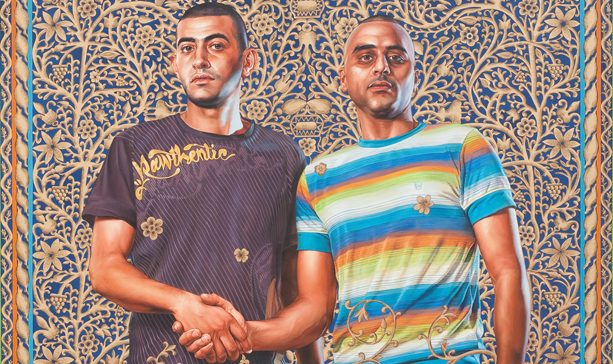
Kehinde Wiley’s “Abed Al Ashe and Chaled El Awari (The World Stage: Israel)
My visit to Chelsea a couple of weeks ago turned up a surprising number of shows with religious content, presented in vastly different ways. I’ve already pointed out the quasi-Gnostic overtones of the Joseph Strau show at Green Naftali, which seemed to be a sincere attempt to produce art inspired by the German artist’s personal spiritual awakening, but at least three other exhibits approached religion in three distinctly different tones. At D.C. Moore, Beasts of Revelation offered a variety of interesting work, but the tone of the press release created a snarky lens through which it was nearly impossible to see any of the work as a genuine attempt to visualize religious faith in a non-judgmental way. Christopher Hitchens, if you’re watching, you should be grinning. The release was more than a bit pretentious, heralding that the show would break new ground into content heretofore taboo for contemporary art. Oh, that again. (Is that even remotely possible anymore?) The fact that, simultaneously, three other exhibits elsewhere in the city were infused with religious content offered a deflating reality check to this bit of bloviating on contemporary art’s ability to “pose uncomfortable questions and provoke disturbing answers.”
What the show appears to be is the gallery’s attempt to visualize what it calls . . . wait for it, wait for it . . the “insidious aquifer of metaphorical power” exerted by “religion” but what’s clearly meant is right-wing Christianity. “Political issues that might have been considered personal during another era have become rallying cries for various religious groups.” It isn’t hard to translate what that means, and some of the idiocies of the Christian right-wing are easy targets for anyone who wants to pound the drum over their knuckle-headedness. Yet a show about “religion” that might have been far more interesting and resonant would have been one with images from Hindu, Muslim, and Buddhist artists, as well as Jewish and Catholic, or maybe even a die-hard Taoist. Or a Rastafarian, anyone? A show that contained sincere images about personal faith: now there would be something that felt like a violation of a more genuine taboo, since we’re talking about More



















